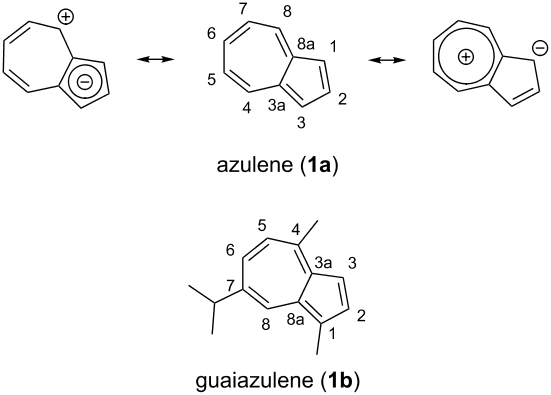Can organic compounds like hydrocarbons have types of bonds other than covalent bonds? Can they also possess ionic bonds?
3 Answers
Azulene has a 1.05 debye dipole moment,

A hydrocarbon as such bonded as an isolated cation-anion pair with no heteroatoms could happen in principle given sufficient steric hindrance. Penta-tert-butylcyclopentadienide or pentakis(2,4,6-tri-tert-butylphenyl)cyclopentadienide with like fully substituted cyclpropenium or tropylium might work.
Similar substitution on fulvalenes' four inner carbons would dihedral angle rotate the rings by steric hindrance. This prevents the double bond from forming, giving sort of a sigma covalent plus pi-dative bond.

-
2$\begingroup$ Very strained theoretical hydrocarbons such as tetrahedrane, pagodane derivatives and higher-order prismanes show considerable acidities and basicities, so I imagine it could be possible for a very special pair of hydrocarbons to directly react in an acid-base reaction and produce a hydrocarbon salt? $\endgroup$ Commented Mar 15, 2014 at 1:38
-
$\begingroup$ Enthalpy of reaction for undesired reaction must be small (e.g., direct electron transfer), steric barriers to undesired bimolecular reaction must be high. Both cyclopentadienide and tropylium have pKa,pKb near water and are very soft, delocalized ions. I doubt (homoaromatic, etc) sigma systems can do better. If you have one.... $\endgroup$– Uncle AlCommented Mar 17, 2014 at 17:02
"Ionic bond" does not necessarily mean the same thing as "bond that is not covalent". For example, I would have a difficult time classifying a hydrogen bond as being either ionic or covalent in nature.
Nevertheless, four different hydrocarbon salts (i.e. salts containing only carbon and hydrogen) have been reported by Okamoto et al. (J. Org. Chem. 1990, 55 (3), 996–1002). The four salts involve carbanion 1 being paired with carbocations 2 through 5:
As you can see, a great deal of aromaticity/conjugation is "employed" in order to stabilise the charges. I don't think the cyclopropyl substituents are a coincidence either, since positive charges $\alpha$ to a cyclopropane ring are stabilised by $\sigma_{\ce{C-C}} \rightarrow p$ donation (see this question).
According to the paper, Kuhn's anion, 1, has a $\mathrm{p}K_\mathrm{b}$ of 8.1. The stabilities of the carbocations are measured differently, using a $\mathrm{p}K_\mathrm{R^+}$ scale:
$$\mathrm{p}K_\mathrm{R^+} = \log \left(\frac{[\ce{R+}]}{[\ce{ROH}]}\right) + H_\mathrm{R}$$
for the equilibrium
$$\ce{ROH + H+ <=> R+ + H2O}$$
where $H_\mathrm{R}$ is an acidity function defined for the medium (for more details, see Carey & Sundberg, Advanced Organic Chemistry: Part A, 5th ed., p 426).
One would expect stable salts to form between Kuhn's anion and carbocations with $\mathrm{p}K_\mathrm{R^+}$ values near 9 to 10. This is indeed so:
$$\begin{array}{cc} \text{Carbocation} & \mathrm{p}K_\mathrm{R^+} \\ \hline \mathbf{2} & >10 \\ \mathbf{3} & ~10 \\ \mathbf{4} & 8.9 \\ \mathbf{5} & 8.7 \end{array}$$
The fact that the compounds existed as ionic salts was proven by IR spectra, UV-VIS spectra, and conductivity measurements.
If you want to expand your question to include "salts made of organic compounds", then another reference is J. Am. Chem. Soc. 1963, 85 (9), 1354–1355.
-
4$\begingroup$ This is brilliant, great find! $\endgroup$ Commented Apr 11, 2016 at 9:33
Yes, of course. Look up for Grignard reagents, it is the most obvious. But there is other type of bounds. Cyan-hydride ligand is another bound type. Generally speaking this kind of not-exactly-covalent-and-close-to-ionic bound occurs with metals.

